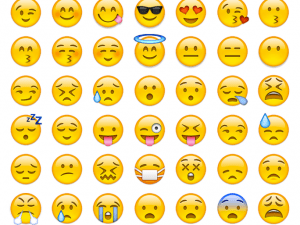What Do Those Smileys Legally Mean? Emoticon and Emoji Law
Nearly every time I send a casual email at work, I add some kind of smiley emoji or emoticon. Just in case someone were to take a joke seriously, I assume that they can interpret that smiley to mean that I am in a good mood or that I’m kidding around.
Given the large array of emojis, which include everything from dancing ladies, to eggplants, to pieces of Japanese food that Americans are ignorant of, it’s becoming more difficult to be able to discern what an emoji is supposed to objectively mean. Yet, we use emojis with greater frequency in many of our communications – emails, social media comments and posts, text messages. With all of the ways that emojis are incorporated into our everyday communications, what happens when those communications go to court?
Emojis in Case Law
Given the relative newness of emojis and emoticons, it’s no wonder that there are no laws that directly address the treatment of these emotion laden symbols. We only have legal cases to determine what courts do with emojis, and even they do not consistently agree to interpret or ignore them.
In some cases, emoticons and emojis are taken under consideration when interpreting a commenter’s original intent. For example, the appeals court in Michigan determined that “The use of the ‘:P’ emoticon makes it patently clear that the commenter was making a joke” because the face this emoticon represents usually “denotes a joke or sarcasm.” 
In a Delaware case, a judge determined that the winking smiley can be interpreted as harassment when a man who was stalking his coworker bought an airline ticket to sit next to her and texted a friend about it. The man argued that the emoticon implied that he was joking, but the judge found that the wink meant he enjoyed another opportunity at harassing his coworker.
In other cases, the judge ignores the emojis or emoticons if they find it does not sufficiently add to the meaning or context of a statement. In a sexual assault case, a judge found that the victim’s winking face reply was not sufficient for consent. In another case, a Michigan law student who was charged with stalking and harassing another student argued that his use of the “:P” when he texted that he wanted the girl to “feel crappy” was to show the comment was a joke. The judge did not find that the emoticon materially altered the meaning of the text.
Rules of Evidence and the Emoticon
As you can see, the same emoticons and emojis can be included or ignored when interpreting a comment or message. It becomes one of many factors used to interpret a person’s original intent.
Potentially, this could make some forms of evidence admissible in court when they are normally excluded. Both Federal and State courts have a variety of rules for the types of evidence that are admissible. One form of evidence that is usually not admissible is hearsay. Hearsay is an out of court statement used for the truth of the matter asserted. In other words, hearsay includes a statement heard second hand that is being brought to court for its truth. This is usually not permitted because it is difficult to prove the truth of that statement since it wasn’t said under oath.
One exception to the hearsay rule is when a statement shows the emotional state of mind of the speaker. So, instead of trying to bring the statement into court for the truth of what it is saying, the statement is being used to show what the speaker was feeling at the time they said it. Emoticons and emojis could be used to show how a person was feeling at the moment the message was texted or commented. The only problem would be if the speaker used an emoji that doesn’t have a clear meaning. For example, recent uses of a panda, eggplant, or even certain food emojis have adopted different meanings for different people.
It’s difficult to say whether emojis and emoticons will have a more reliable interpretation at court in the future. Since these little icons are becoming more prevalent in our communications, it may push the courts to find a more standardized way of handling them in the future. You never know 😛
What our clients think
At LegalMatch, we value our client’s opinion and make it a point to address their concerns. You can refer to our reviews page if you want to know what our clients have to say about us.


Comments